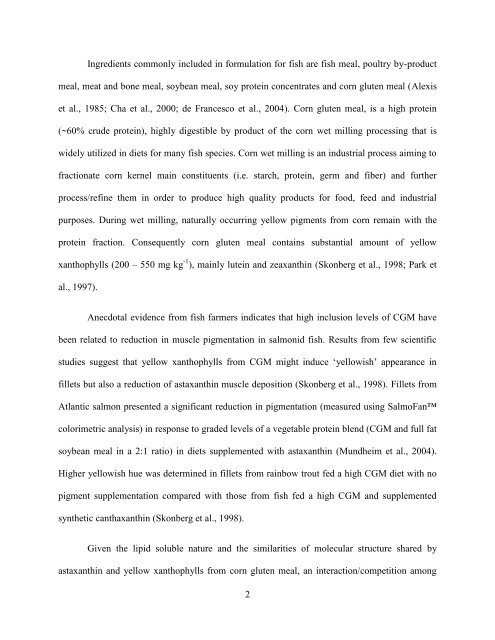Pigment Reduction in Corn Gluten Meal and Its Effects on Muscle ...
Pigment Reduction in Corn Gluten Meal and Its Effects on Muscle ...
Pigment Reduction in Corn Gluten Meal and Its Effects on Muscle ...
Create successful ePaper yourself
Turn your PDF publications into a flip-book with our unique Google optimized e-Paper software.
Ingredients comm<strong>on</strong>ly <str<strong>on</strong>g>in</str<strong>on</strong>g>cluded <str<strong>on</strong>g>in</str<strong>on</strong>g> formulati<strong>on</strong> for fish are fish meal, poultry by-productmeal, meat <str<strong>on</strong>g>and</str<strong>on</strong>g> b<strong>on</strong>e meal, soybean meal, soy prote<str<strong>on</strong>g>in</str<strong>on</strong>g> c<strong>on</strong>centrates <str<strong>on</strong>g>and</str<strong>on</strong>g> corn gluten meal (Alexiset al., 1985; Cha et al., 2000; de Francesco et al., 2004). <str<strong>on</strong>g>Corn</str<strong>on</strong>g> gluten meal, is a high prote<str<strong>on</strong>g>in</str<strong>on</strong>g>(~60% crude prote<str<strong>on</strong>g>in</str<strong>on</strong>g>), highly digestible by product of the corn wet mill<str<strong>on</strong>g>in</str<strong>on</strong>g>g process<str<strong>on</strong>g>in</str<strong>on</strong>g>g that iswidely utilized <str<strong>on</strong>g>in</str<strong>on</strong>g> diets for many fish species. <str<strong>on</strong>g>Corn</str<strong>on</strong>g> wet mill<str<strong>on</strong>g>in</str<strong>on</strong>g>g is an <str<strong>on</strong>g>in</str<strong>on</strong>g>dustrial process aim<str<strong>on</strong>g>in</str<strong>on</strong>g>g tofracti<strong>on</strong>ate corn kernel ma<str<strong>on</strong>g>in</str<strong>on</strong>g> c<strong>on</strong>stituents (i.e. starch, prote<str<strong>on</strong>g>in</str<strong>on</strong>g>, germ <str<strong>on</strong>g>and</str<strong>on</strong>g> fiber) <str<strong>on</strong>g>and</str<strong>on</strong>g> furtherprocess/ref<str<strong>on</strong>g>in</str<strong>on</strong>g>e them <str<strong>on</strong>g>in</str<strong>on</strong>g> order to produce high quality products for food, feed <str<strong>on</strong>g>and</str<strong>on</strong>g> <str<strong>on</strong>g>in</str<strong>on</strong>g>dustrialpurposes. Dur<str<strong>on</strong>g>in</str<strong>on</strong>g>g wet mill<str<strong>on</strong>g>in</str<strong>on</strong>g>g, naturally occurr<str<strong>on</strong>g>in</str<strong>on</strong>g>g yellow pigments from corn rema<str<strong>on</strong>g>in</str<strong>on</strong>g> with theprote<str<strong>on</strong>g>in</str<strong>on</strong>g> fracti<strong>on</strong>. C<strong>on</strong>sequently corn gluten meal c<strong>on</strong>ta<str<strong>on</strong>g>in</str<strong>on</strong>g>s substantial amount of yellowxanthophylls (200 – 550 mg kg -1 ), ma<str<strong>on</strong>g>in</str<strong>on</strong>g>ly lute<str<strong>on</strong>g>in</str<strong>on</strong>g> <str<strong>on</strong>g>and</str<strong>on</strong>g> zeaxanth<str<strong>on</strong>g>in</str<strong>on</strong>g> (Sk<strong>on</strong>berg et al., 1998; Park etal., 1997).Anecdotal evidence from fish farmers <str<strong>on</strong>g>in</str<strong>on</strong>g>dicates that high <str<strong>on</strong>g>in</str<strong>on</strong>g>clusi<strong>on</strong> levels of CGM havebeen related to reducti<strong>on</strong> <str<strong>on</strong>g>in</str<strong>on</strong>g> muscle pigmentati<strong>on</strong> <str<strong>on</strong>g>in</str<strong>on</strong>g> salm<strong>on</strong>id fish. Results from few scientificstudies suggest that yellow xanthophylls from CGM might <str<strong>on</strong>g>in</str<strong>on</strong>g>duce ‘yellowish’ appearance <str<strong>on</strong>g>in</str<strong>on</strong>g>fillets but also a reducti<strong>on</strong> of astaxanth<str<strong>on</strong>g>in</str<strong>on</strong>g> muscle depositi<strong>on</strong> (Sk<strong>on</strong>berg et al., 1998). Fillets fromAtlantic salm<strong>on</strong> presented a significant reducti<strong>on</strong> <str<strong>on</strong>g>in</str<strong>on</strong>g> pigmentati<strong>on</strong> (measured us<str<strong>on</strong>g>in</str<strong>on</strong>g>g SalmoFancolorimetric analysis) <str<strong>on</strong>g>in</str<strong>on</strong>g> resp<strong>on</strong>se to graded levels of a vegetable prote<str<strong>on</strong>g>in</str<strong>on</strong>g> blend (CGM <str<strong>on</strong>g>and</str<strong>on</strong>g> full fatsoybean meal <str<strong>on</strong>g>in</str<strong>on</strong>g> a 2:1 ratio) <str<strong>on</strong>g>in</str<strong>on</strong>g> diets supplemented with astaxanth<str<strong>on</strong>g>in</str<strong>on</strong>g> (Mundheim et al., 2004).Higher yellowish hue was determ<str<strong>on</strong>g>in</str<strong>on</strong>g>ed <str<strong>on</strong>g>in</str<strong>on</strong>g> fillets from ra<str<strong>on</strong>g>in</str<strong>on</strong>g>bow trout fed a high CGM diet with nopigment supplementati<strong>on</strong> compared with those from fish fed a high CGM <str<strong>on</strong>g>and</str<strong>on</strong>g> supplementedsynthetic canthaxanth<str<strong>on</strong>g>in</str<strong>on</strong>g> (Sk<strong>on</strong>berg et al., 1998).Given the lipid soluble nature <str<strong>on</strong>g>and</str<strong>on</strong>g> the similarities of molecular structure shared byastaxanth<str<strong>on</strong>g>in</str<strong>on</strong>g> <str<strong>on</strong>g>and</str<strong>on</strong>g> yellow xanthophylls from corn gluten meal, an <str<strong>on</strong>g>in</str<strong>on</strong>g>teracti<strong>on</strong>/competiti<strong>on</strong> am<strong>on</strong>g2
















